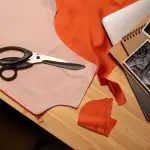Have you ever wondered how wool goes from being a simple fiber to becoming the cozy fabric we love? In this article, we’ll take you through the journey of wool, from shearing the sheep to weaving or knitting the fabric.
You’ll learn about the steps involved, such as sorting, cleaning, carding, and spinning, as well as the finishing and dyeing process.
By the end, you’ll have a clear understanding of how wool transforms into the fabric we use every day.
Table of Contents
The Shearing Process
The wool industry uses electric clippers in the shearing process to remove fleece from the sheep. Shearing techniques have evolved over time to ensure the sheep’s welfare and maximize wool production. Skilled shearers employ various techniques to efficiently shear the sheep, minimizing stress and discomfort. They carefully maneuver the electric clippers, swiftly removing the fleece in one piece. This process is crucial to maintaining the quality of the wool.
After shearing, the wool is graded based on its quality and characteristics. Wool grading involves sorting the fleece into different categories, such as fineness, length, and color. Skilled graders carefully assess the wool, taking into consideration its softness, strength, and uniformity. This classification system ensures that the wool is used appropriately for different applications, such as clothing, carpets, or bedding.
Shearing and wool grading are essential steps in the wool production process. By using electric clippers, shearers can efficiently remove the fleece from sheep, promoting their well-being. The grading process ensures that the wool is sorted and utilized appropriately, meeting the diverse needs of various industries. These techniques and practices help maintain the quality of wool, making it a valuable and versatile natural fiber.
Sorting and Cleaning the Wool
When it comes to sorting and cleaning wool, there are several methods that you can use.
First, you’ll want to sort the wool fibers based on their quality and color.
Then, you can use various cleaning methods to remove dirt, grease, and other impurities from the wool.
Wool Cleaning Methods
To clean wool, you’ll need to choose between different methods such as scouring or dry cleaning. Scouring is the most common method used for cleaning wool, where the fibers are soaked in hot water and detergent to remove dirt, grease, and impurities. Dry cleaning, on the other hand, involves using chemicals to dissolve and remove stains without the need for water.
When it comes to eco-friendly wool cleaning, there are alternative methods available that minimize the use of harmful chemicals and reduce water consumption. One such method is the use of biodegradable detergents and enzyme-based cleaners, which are gentle on the environment and still effectively clean the wool fibers. Another eco-friendly option is handwashing, where you can control the water usage and ensure proper rinsing to remove all the dirt and detergent residues.
Here is a table comparing different wool washing techniques:
| Wool Washing Technique | Description |
|---|---|
| Scouring | Uses hot water and detergent to clean wool fibers |
| Dry Cleaning | Uses chemicals to dissolve and remove stains without water |
| Biodegradable Detergents | Eco-friendly option that minimizes the use of harmful chemicals |
| Enzyme-based Cleaners | Gentle on the environment and effectively clean wool fibers |
| Handwashing | Allows for control over water usage and proper rinsing to remove dirt and detergent residues |
Choose the method that suits your needs and preferences, while also considering the environmental impact.
Sorting Wool Fibers
Sorting wool fibers involves separating them based on their different characteristics, such as length, color, and fineness.
Wool fiber classification is an important step in the wool processing industry, as it allows for the production of high-quality yarn and fabric.
During the sorting process, the fibers are examined and graded according to their length, which determines their suitability for different applications.
The color of the fibers is also taken into consideration, as it can affect the final appearance of the fabric.
Additionally, the fineness of the fibers is assessed to determine their softness and comfort.
Wool fiber grading is a complex task that requires expertise and precision to ensure that only the best fibers are used in the production of woolen products.
Preparing Wool for Processing
During the initial stage of preparing wool for processing, you carefully wash and cleanse the fibers to remove any impurities. This is an important step in the wool preparation techniques, as it ensures that the fibers are clean and ready for further processing.
After washing, the wool is usually dried and then carded to align the fibers in a uniform manner. Carding helps to remove any remaining impurities and creates a more uniform and consistent fiber structure.
Once the wool fibers are carded, they can be spun into yarn, which is then used to create various woolen products.
Overall, these wool processing steps are essential in transforming raw wool into a usable material for fabric production.
Carding and Combing
When it comes to carding and combing, the fiber alignment process is crucial in creating smooth and consistent yarn.
By combing or carding the fibers, you can remove impurities and tangles, resulting in a cleaner and more uniform product.
The end result is a yarn that is ready to be spun into fabric, with all the fibers aligned in the same direction for a more even and cohesive texture.
Fiber Alignment Process
The fiber alignment process begins by combing the wool fibers in order to create a smooth and uniform fabric. Combing helps to remove any tangles or knots in the fibers, ensuring that they are aligned in the same direction. This is crucial for producing a high-quality fabric with even texture and strength.
To convey a deeper meaning for the audience, here are five key points about the fiber alignment process:
-
Fiber blending: Different types of wool fibers may be blended together to create a desired texture, color, or performance characteristics in the fabric.
-
Fiber spinning: Once the fibers are aligned, they are spun into yarn using various spinning techniques, such as ring spinning or worsted spinning.
-
Consistency: The combing process ensures that the fibers are consistent in length and thickness, resulting in a more uniform fabric.
-
Softness: Combing can help to remove shorter and coarser fibers, resulting in a softer and more luxurious fabric.
-
End use: The fiber alignment process is crucial in determining the suitability of the wool fabric for different end uses, such as clothing, blankets, or upholstery.
Removing Impurities and Tangles
Now that the fibers are aligned, it’s time to remove any dirt, debris, and tangles from the wool. This step is crucial to ensure the quality and cleanliness of the final fabric.
To begin, the wool is thoroughly washed to remove any impurities. This process typically involves soaking the wool in a mixture of water and mild detergent, followed by gentle agitation to loosen and lift away dirt particles.
Once clean, the wool is carefully untangled to separate any fibers that may have become intertwined during the washing process. This is done by combing or brushing the wool with specialized tools, untangling each strand to ensure a smooth and even texture.
Creating Smooth, Consistent Yarn
To create smooth, consistent yarn, you’ll need to carefully spin the fibers together in a controlled and even manner. This process requires specific yarn spinning techniques that ensure the fibers are twisted together evenly. Here are some techniques to consider:
- Ring spinning: This traditional method involves pulling the fibers through a series of rollers and twisting them into a continuous yarn.
- Open-end spinning: This newer technique uses a rotor to spin the fibers together, resulting in a more cost-effective and faster process.
- Worsted spinning: In this method, longer fibers are aligned parallel to each other before being twisted into yarn, creating a smoother and stronger finished product.
- Woolen spinning: This technique allows for a loftier, softer yarn by using shorter fibers and incorporating air pockets during the process.
- S-twist and Z-twist: These terms refer to the direction in which the yarn is twisted, with S-twist being clockwise and Z-twist being counterclockwise.
After spinning the yarn, various types of yarn finishes can be applied to enhance its appearance, durability, or performance. These finishes include:
- Mercerization: This treatment increases the yarn’s luster and strength by immersing it in a caustic soda solution.
- Superwash: This finish makes the yarn machine washable and resistant to felting by removing the scales on the wool fibers.
- Anti-pilling: This finish reduces the formation of pills, those annoying little balls of fibers that form on the surface of yarn over time.
- Flame retardant: This finish adds a layer of protection to the yarn, making it less likely to catch fire.
- Softening: This finish involves treating the yarn with chemicals or enzymes to make it softer to the touch.
Spinning the Wool Into Yarn
After she shears the sheep, the wool is cleaned and carded before it can be spun into yarn. Yarn production involves various spinning techniques to transform the wool fibers into usable yarn.
The first step in spinning the wool is to align the fibers by combing or carding them. Combing removes the shorter fibers, leaving behind only the long and smooth ones. Carding, on the other hand, uses a carding tool or machine to separate and align the fibers. Once the fibers are aligned, they are ready to be spun.
Spinning can be done using different methods, such as hand spinning or machine spinning. Hand spinning involves using a spinning wheel or drop spindle to twist the fibers together, creating yarn. This method requires skill and practice to achieve consistent thickness and tension in the yarn.
Machine spinning, on the other hand, uses spinning machines to automate the process. These machines can spin large quantities of yarn quickly and efficiently. They work by drawing out the fibers, twisting them together, and winding the resulting yarn onto bobbins or cones.
Once the yarn is spun, it can be further processed and dyed before it is ready for weaving or knitting. Spinning is a crucial step in yarn production, as it determines the quality and characteristics of the final product.
Weaving or Knitting the Fabric
You can weave or knit the spun yarn into a fabric of your choice. Both weaving and knitting are popular techniques used to create beautiful and functional fabrics. Here are some key points to consider:
-
Weaving techniques: Weaving involves interlacing the yarns at right angles to create a stable fabric. This can be done on a loom, which holds the warp (vertical) threads taut, while the weft (horizontal) threads are woven through. Different patterns and textures can be achieved by varying the yarns and weaving techniques.
-
Knitting patterns: Knitting, on the other hand, uses a set of needles to create loops and interlock them to form a fabric. Knitting patterns determine the arrangement of these loops, resulting in various textures and designs. From simple stitches like stockinette and garter stitch to intricate lace or cable patterns, there are endless possibilities for creating unique knitted fabrics.
-
Versatility: Weaving and knitting allow you to create fabrics for different purposes, from clothing and accessories to home decor items like blankets and rugs. The choice of technique depends on the desired outcome and the yarn you are working with.
-
Skill level: Weaving can be more complex and requires a loom, while knitting can be done with just a few needles. Both techniques have their learning curves, but with practice, you can master them and create stunning fabrics.
-
Creativity: Weaving and knitting offer endless opportunities for creativity. You can experiment with different yarns, colors, patterns, and textures to make one-of-a-kind fabrics that reflect your personal style and artistic vision.
Finishing and Dyeing the Wool Fabric
After the wool fabric is woven or knitted, it goes through the process of finishing and dyeing. This is where the fabric is treated to achieve its final look and feel.
When it comes to dyeing wool, there are various techniques and methods used. Some common dyeing techniques include immersion dyeing, where the fabric is completely submerged in a dye bath, and hand-painting, where the dye is applied to specific areas of the fabric by hand.
In recent years, there has been a growing emphasis on sustainable dyeing methods. These methods aim to minimize the environmental impact of the dyeing process by reducing water and energy consumption, as well as the use of harmful chemicals. One example of a sustainable dyeing method is natural dyeing, which involves using plant-based dyes that are non-toxic and biodegradable. Another sustainable technique is low-impact dyeing, which uses dyes that require less water and energy to produce.
In summary, finishing and dyeing are essential steps in the process of transforming wool fiber into fabric. While various dyeing techniques are used, there is a growing trend towards sustainable methods that prioritize environmental responsibility.
Imagery Table:
| Dyeing Technique | Description | Example |
|---|---|---|
| Immersion Dyeing | Fabric is completely submerged in a dye bath | Dyeing a white wool fabric in a vibrant blue color |
| Hand-painting | Dye is applied to specific areas of the fabric by hand | Creating a unique pattern on a wool scarf using dyes |
| Natural Dyeing | Plant-based dyes that are non-toxic and biodegradable | Using beetroot to dye wool fabric a soft pink color |
| Low-Impact Dyeing | Uses dyes that require less water and energy to produce | Dyeing wool fabric using dyes made from recycled materials |
Conclusion
So there you have it! You’ve learned about the journey of wool, from fiber to fabric.
Starting with the shearing process, where the wool is carefully removed from the sheep, to sorting and cleaning the wool to remove any impurities.
Then comes carding and combing, which aligns the fibers and removes any tangles.
After that, the wool is spun into yarn, which can then be either woven or knitted to create the fabric.
Finally, the fabric goes through finishing and dyeing processes to give it its desired look and feel.
- Choosing the Right Fabrics for Babies - July 20, 2024
- Impact of Fabrics on Skin Health - July 20, 2024
- Benefits of Antimicrobial Fabrics - July 20, 2024





